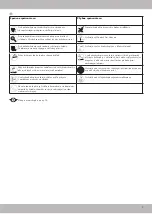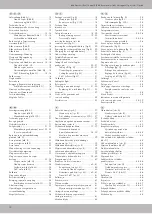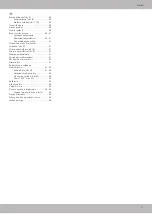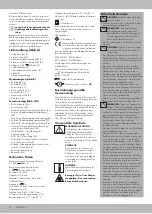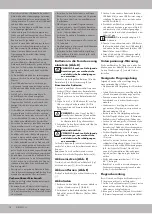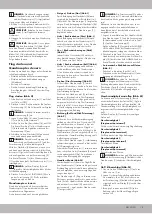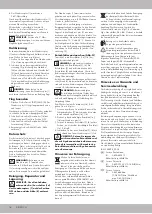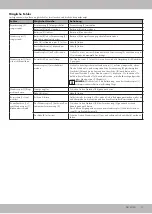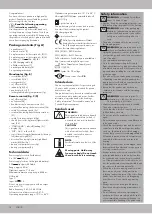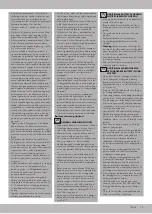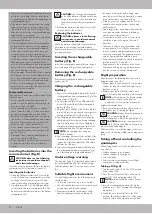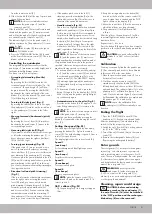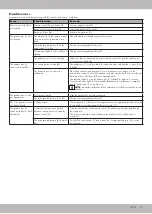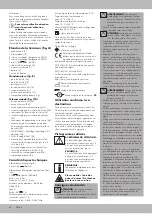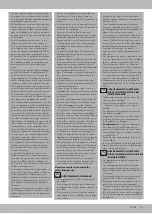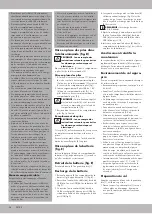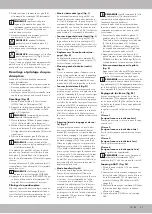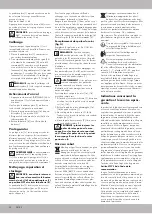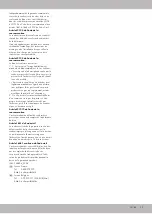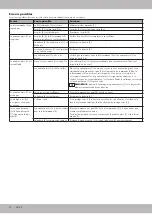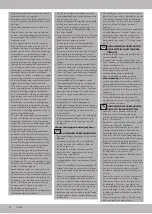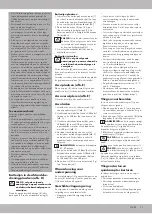
21
GB/IE
from the remote control (2).
5. Slide the throttle (2h) all the way forward, and
then all the way back.
NOTE:
this process establishes contact
between the quadcopter (1) and the
remote control (2).
If the throttle (2h) is not first moved forward and
then back, the quadcopter (1) remains secured
and will not be ready for flight. Acoustic signals
are emitted from the remote control (2).
The indicator lights (1e) on the quadcopter (1)
light up continuously. The quadcopter (1) is now
ready for flight.
NOTE:
the display (2j) shows the speed
and ‘NORMAL’ mode.
6. Press the ‘START/LAND’ button (2i), located
at the front of the remote control (2). The rotor
blades will start to turn.
Controlling the quadcopter
The integrated height sensor ensures that the
quadcopter (1) maintains a steady height, and it
facilitates initial flight manoeuvres.
You have several control options:
• Ascending/descending (throttle)
(Fig. I)
By pressing the throttle (2h) forwards, the
rotational speed of the rotor blades (1a, 1b)
is increased. The quadcopter (1) will then
begin to ascend. By moving the throttle (2h)
backwards, the rotational speed of the rotor
blades (1a, 1b) is decreased. The quadcopter
(1) will then begin to descend.
• Turning left/right (yaw) (Fig. J)
By moving the throttle (2h) to the left or right,
the quadcopter (1) rotates on the vertical axis,
i.e. the quadcopter (1) rotates to the left or
right.
• Moving forwards/backwards (pitch)
(Fig. K)
By moving the control lever (2l) forwards or
backwards, the quadcopter (1) moves in the
corresponding direction.
• Hovering left/right (roll) (Fig. L)
If you want to perform a movement to the right
or left without rotating the quadcopter (1), i.e.
hover sideways, move the right control lever
(2l) to the left or right.
• Turning (yaw trimming) (Fig. O)
If the quadcopter (1) moves around its own
axis of its own accord without you moving
the control lever (2l), you can correct this with
yaw trimming. If the quadcopter (1) is turning
clockwise, press the yaw-trim button to the left
(2f), and if it is turning anti-clockwise, press the
yaw-trim button to the right (2d). In this way
you counter the yaw movement by trimming in
the opposite direction.
• Direction (roll and pitch trimming)
(Fig. P)
If there is a forwards or backwards movement,
even though you are not using the control
lever (2l) at all, you can correct this with
pitch trimming. If the quadcopter (1) is flying
forwards, press the pitch-trim button (2o)
and vice versa (2m). You can counteract the
unwanted movement with the trim setting. If
the quadcopter (1) moves sideways of its own
accord, you can correct this by roll trimming.
• If the quadcopter hovers to the left (1)
sideways, press the trim button (2n) to the
right and vice versa (2p). This allows you to
counteract the unwanted movement.
• Headless mode (Fig. Q)
This refers to a flight aid that, when activated,
enables the quadcopter (1) to always fly in
the direction it is steered. It is recommended
for pilots with little flying experience. For ex-
ample, when headless mode is activated using
the button (2c), from the pilot’s viewpoint,
the quadcopter (1) always flies to the right
when the control lever (2l) is steered to the
right, regardless of which way the front of the
quadcopter (1) is facing.
NOTE:
the direction of the remote control
(2) and the quadcopter (1) must corre-
spond exactly when activating headless mode!
Only activate headless mode in the position
specified, otherwise it may result in control com-
mands not being carried out correctly.
1. To activate headless mode, put the quadcop-
ter (1) and the remote control (2) one behind
the other and press the button (2c) on the
remote control (2). The ‘HEADLESS’ display
(2j) message lights up and the quadcopter
(1) lights flash slowly as long as the mode is
activated.
2. To deactivate Headless mode, press the
button (2c) again. On the display (2j), ‘NOR-
MAL’ is lit up and the quadcopter lights light
up continuously again.
• Automatic return to the pilot (Fig. R)
Press the active button (2c) for approx. 3 sec-
onds if the quadcopter (1) is to return to the
starting point.
NOTE:
the return route can vary as a result
of the quadcopter (1) turning. The
operation can be cancelled by pressing the
button (2c) repeatedly or by moving the control
lever (2l).
Setting the speed (Fig. M)
You can adjust the flight speed by repeatedly
pressing the buttons (2e, 2g) on the remote
control (2). The default setting is speed 2, from a
total of four speed levels.
The display lights show the various levels (2j).
Speed 1
(one beep)
For first attempts with little flight experience.
Speed 2
(two beeps)
For pilots with some experience.
Speed 3
(three beeps)
For experienced pilots.
Speed 4
(four beeps)
For very experienced pilots.
NOTE:
when the remote control (2) is
turned off and on, the quadcopter (1) is
reset to speed 2.
360° rollover (Fig. N)
1. Fly the quadcopter (1) to a height of approx.
10m.
2. Keep it hovering and press the button (2k)
located at the front of the remote control (2)
once. A signal tone is emitted and the ‘FLIP’
light is shown on the display (2j).
3. Move the control lever (2l) in the direction in
which the rollover is to be performed.
4. The quadcopter (1) will perform a 360°
rollover.
After the rollover, the quadcopter (1) will be
in normal flight mode and you can perform
another rollover.
Repeat steps 1–4 to do so.
Press the button (2k) again if you do not want to
perform a rollover, but had already pressed the
button.
CAUTION:
you need sufficient flight
altitude for a 360° rollover (at least
10m).
Calibration
You may occasionally find that the quadcopter
(1) flies erratically and needs to be calibrated.
In this event, follow the steps below:
1. Place the powered-on quadcopter (1) on a
horizontal, level surface.
2. On the powered-on remote control (2),
simultaneously slide the throttle (2h) to the
left and back, and the control lever (2l) to the
right and back. The indicator lights (1e) on the
quadcopter (1) will flash for approx. 3 sec-
onds. Once the indicator lights (1e) are stead-
ily illuminated, the calibration is complete and
the quadcopter (1) is ready to fly.
NOTE:
repeat the calibration if the
quadcopter (1) still flies erratically in one
direction.
Ending the flight
1. Press the ‘START/LAND’ button (2i). The
quadcopter (1) slowly descends and lands.
After the quadcopter (1) has landed safely,
switch it off in the proper sequence.
2. Switch the on/off switch (1d) on the quadcop-
ter (1) to the ‘OFF’ position.
3. Turn off the on/off switch (2a) on the remote
control (2).
4. Remove the rechargeable battery (8) (see
‘Removing the rechargeable battery’).
Rotor guards
The rotor guards (1c) act as protection against
injuries (e.g. cuts, skin injuries or eye injuries)
and to protect against, or in the event of, colli-
sions. These are firmly mounted. If a rotor guard
(1c) becomes loose, tighten the screws again
and double-check the function and correct place-
ment of the rotor guard (1c).
WARNING:
never operate the
quadcopter (1) without rotor guards
(1c)! Do not remove the rotor guards (1c)
arbitrarily so as not to endanger yourself, and/
or other people and animals!
Cleaning, repair and storage
CAUTION: before undertaking
any work on the quadcopter (1),
the on/off switch (1d) must be switched
to the ‘OFF’ position and the rechargea-
ble battery (8) must be removed.
Содержание 345898 2004
Страница 2: ...B G F H I J K E A C D ...
Страница 3: ...5 L N M P O R Q ...
Страница 53: ...55 ...
Страница 54: ...56 03 09 2021 AM 11 32 ...



